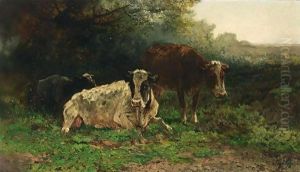Hendricus Alexander Van Ingen Paintings
Hendricus Alexander Van Ingen, born in 1866, was a Dutch artist whose work primarily spans the realms of painting and drawing. Although not as widely recognized as some of his contemporaries in the Dutch art scene, Van Ingen contributed significantly to the visual arts during his lifetime, showcasing a talent for capturing the essence of his subjects with a unique touch of realism and emotional depth.
His early life was marked by an immersion in the rich artistic culture of the Netherlands, a country renowned for its legacy in the visual arts, dating back to the Dutch Golden Age. This environment undoubtedly influenced Van Ingen, shaping his aspirations and honing his skills as an artist. Despite the scarcity of detailed records about his educational background, it is believed that he received formal art training, a common practice among artists of his time, which would have provided him with the technical skills and artistic sensibilities characteristic of his later works.
Throughout his career, Van Ingen focused on both landscapes and portraits, demonstrating versatility in his choice of subjects. His landscapes often depicted the serene and picturesque Dutch countryside, reflecting a deep appreciation for his natural surroundings. These works are characterized by their attention to detail and a subtle use of color, which together create a sense of tranquility and timeless beauty. On the other hand, his portraits reveal a keen eye for capturing the human condition, with each piece offering a glimpse into the personality and inner life of its subject. Van Ingen's ability to convey emotion through facial expressions and posture made his portraits particularly compelling.
Despite his talent, Hendricus Alexander Van Ingen remains a somewhat obscure figure in the art world. His works, while appreciated, did not gain the widespread acclaim or commercial success achieved by some of his peers. Nevertheless, he left behind a body of work that continues to be appreciated by art historians and collectors for its craftsmanship and emotional resonance.
Van Ingen's life came to an end in 1923, but his art remains as a testament to his skill and sensitivity as an artist. While the details of his personal life and career might not be as well documented as those of more famous artists, the quality and depth of his work ensure that he holds a place in the annals of Dutch art history. His contributions, though perhaps modest in comparison to the giants of the art world, reflect a genuine commitment to the exploration of beauty, emotion, and the human experience through visual expression.
